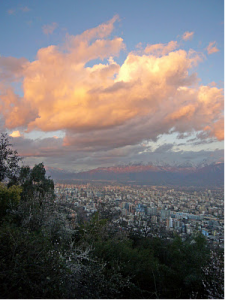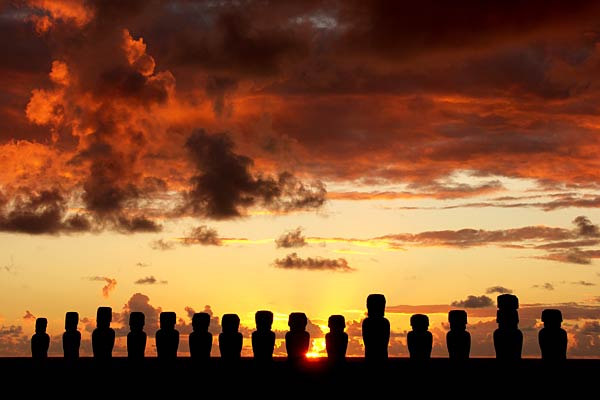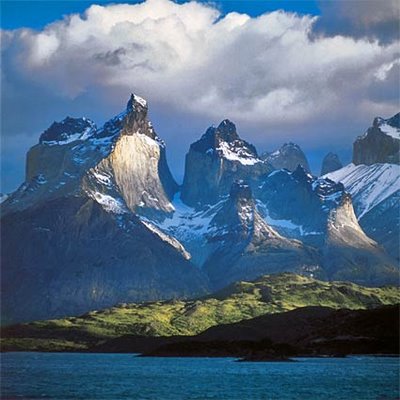Below is a top ten list of things worth doing and seeing if you’re planning a trip to Chile, or wasn’t planning a trip to Chile and perhaps after reading, a visual or description or two will change your mind.
The Magical and Isolated Easter Island:
A special territory of Chile that was annexed in 1888, Easter Island is famous for its 887 extant monumental statues, called moai, created by the early Rapanui people. It is a World Heritage Site with most of the island protected inside Rapa Nui National Park. Easter Island is claimed to be the most remote inhabited island in the world and apparently, the lineage of folks who live in Easter Island trace back to Polynesia and Micronesia, not the migration originally thought. How’s this for breathtaking?
Patagonia aka the Switzerland of the South:
You’ll see why they call Patagonia the Switzerland of the South. Taking in the southernmost section of the Andes mountains to the southwest towards the Pacific ocean and from the east of the cordillera to the valleys, it follows south through Colorado River towards Carmen de Patagones in the Atlantic Ocean. The name Patagonia comes from the word patagón used by Magellan in 1520 to describe the native people that his expedition thought to be giants. Breathtaking. If the images don’t get you there, then I don’t know what will. Below is Grey Glacier, which is part of Torres del Paine National Park.
Valparaiso:
Not far from Santiago, Valparaíso played an important geopolitical role in the second half of the 19th century, when the city served as a major stopover for ships traveling between the Atlantic and Pacific oceans by crossing the Straits of Magellan. Always a magnet for European immigrants, Valparaíso mushroomed during its golden age, when the city was known by international sailors as “Little San Francisco” and “The Jewel of the Pacific.” Examples of Valparaíso’s former glory include Latin America’s oldest stock exchange, the continent’s first volunteer fire department, Chile’s first public library, and the oldest Spanish language newspaper in continuous publication in the world.
Wine Tasting in Chilean Wineries:
You can venture up for day tours from Santiago or head up and spend more time. Two of the oldest and most historic wineries in the country include Cousino Macul, founded in 1856 and Concha y Toro winery.
Vina Del Mar:
Vina Del Mar translates to “Vineyard by the Sea”, and is located along Chile’s Pacific coast, white sandy beaches stretching for miles. Viña del Mar is part of the Greater Valparaíso area, and where you want to venture if you’re after white sand…check out “the be seen” Reñaca Beach, Las Salinas Beach. A major attraction is its Viña del Mar Municipal Casino founded in 1930, it is one the oldest gambling establishments in South America. Each Summer in late February, the town hosts its Viña del Mar International Song Festival. The Festival ground is nestled in the striking natural tree lined hill of Quinta Vergara Amphitheater. Another major attraction is the Viña del Mar Film Festival, founded in 1967 as the First Latin American Film Festival and was also the first gathering of Latin American filmmakers.
Santiago:
Teatro Municipal is a neoclassical building that houses performing arts including the Ballet de Santiago, world-class opera, tango and classical music performances. Nightlife happens for the most part in the area of Santiago called Bellavista, which is loaded with bars, nightclubs and places to go dancing late into night.
 Also in Santiago is La Chascona, which is what poet Pablo Neruda built as a secret hideaway to spend time with his mistress Matilde Urrutia. You can take guided tours which not only cover the history of the building but show you the collection of colored glass, shells, furniture and artworks by many of Neruda’s famous friends, most of which got stolen when the house was ransacked during the dictatorship.
Also in Santiago is La Chascona, which is what poet Pablo Neruda built as a secret hideaway to spend time with his mistress Matilde Urrutia. You can take guided tours which not only cover the history of the building but show you the collection of colored glass, shells, furniture and artworks by many of Neruda’s famous friends, most of which got stolen when the house was ransacked during the dictatorship.
The Iglesia de San Francisco was build starting in 1586, making it Santiago’s oldest surviving colonial building. On the main altar look for the carving of the Virgen del Socorro (Our Lady of Perpetual Help), which Santiago’s founder Pedro de Valdivia brought to Chile on his 1540 conquistador mission to protect him from attacks.
For food, check out Ligura, which is an institution in Santiago. They serve stewed rabbit and silverside in batter on red-checked tablecloths, all of which is surrounded by Chilean memorabilia and old bottles which adorn a wood-paneled inside.
Museo de Colchagua in Santa Cruz:
This renowned largest, private museum displays Cardoén’s collections of paleontological specimens, pre-Columbian art, and historical materials, including a remarkable assortment of antique carriages and farm machinery. Its professional organization matches or surpasses that of Santiago’s Museo Chileno de Arte Precolombino.
Carlos Cardoen has made a name for himself as a hard-core collector and his collection includes pre-Columbian anthropomorphic ceramics from all over Latin America; weapons, religious artifacts and Mapuche silver; and a whole room of huasos cowboy gear. Steam-driven machinery, winemaking equipment and a re-creation of Colchagua’s original train station fill the huge courtyard, and adjoining display rooms showcase old carriages and vintage cars.
Parque Nacional Huerquehue in Pucon Chile:
Parque Nacional Huerquehue protects 12,500 hectares (30,888 acres) of rivers and waterfalls, alpine lakes and araucaria forests. It’s easily accessible and has an array of trails. Conaf sells decent trail maps at the entrance, where there’s a Centro de Educación e Intepretación Ambiental (park information office).
Palacio de la Moneda:
Chile’s presidential offices are in the Palacio de la Moneda is where Chile’s presidential offices are located. Imagine an ornate neoclassical building designed by an Italian, well known Italian architect Joaquín Toesca that is. He designed the building in the late 18th century and its name actually translates to ‘the coin.’
The Atacama Desert:
Filled with gorgeous and unusual rock formations, the Atacama Desert is apparently the highest and driest desert in the world according to National Geographic, NASA and others. It covers 600-miles on the Pacific coast, west of the Andes mountains. It is composed mostly of salt basins (salares), sand, and felsic lava flows and is a must visit as it is absolutely breathtaking if you’re a nature lover.
This South America site has a fun 200 things to do in Chile list, which is personal, but useful to check out. Also check out this page for fabulous Chile festivals and events by month. Also worth checking out is this post on What Not To Do in Chile, and this site with things specific to Santiago.
Photo Credits: Easter Island Shot (WanderingTrader), Vina Del Mar (YahooTravel), Grey Glacier (thisandthatandmoreoffthesame), Atacama Desert (ZMEScience), Santiago (SantiagoTourist).

Renee Blodgett is the founder of We Blog the World. The site combines the magic of an online culture and travel magazine with a global blog network and has contributors from every continent in the world. Having lived in 10 countries and explored over 90, she is an avid traveler, and a lover, observer and participant in cultural diversity. She is also the founder of the Magdalene Collection, a jewelry line dedicated to women’s unsung voices and stories, and the award-winning author of the bestselling book Magdalene’s Journey
She is founder of Blue Soul Media and co-founder of Blue Soul Earth as well as the producer and host of the award-winning Blue Soul CHATS podcast, that bridges science, technology and spirituality. Renee also founded Magic Sauce Media, a new media services consultancy focused on viral marketing, social media, branding, events and PR. For over 20 years, she has helped companies from 12 countries get traction in the market. Known for her global and organic approach to product and corporate launches, Renee practices what she pitches and as an active user of social media, she helps clients navigate digital waters from around the world. Renee has been blogging for over 16 years and regularly writes on her personal blog Down the Avenue, Huffington Post, BlogHer, We Blog the World and other sites. She was ranked #12 Social Media Influencer by Forbes Magazine and is listed as a new media influencer and game changer on various sites and books on the new media revolution. In 2013, she was listed as the 6th most influential woman in social media by Forbes Magazine on a Top 20 List.
Her passion for art, storytelling and photography led to the launch of Magic Sauce Photography, which is a visual extension of her writing, the result of which has led to producing six photo books: Galapagos Islands, London, South Africa, Rome, Urbanization and Ecuador.
Renee is also the co-founder of Traveling Geeks, an initiative that brings entrepreneurs, thought leaders, bloggers, creators, curators and influencers to other countries to share and learn from peers, governments, corporations, and the general public in order to educate, share, evaluate, and promote innovative technologies.












